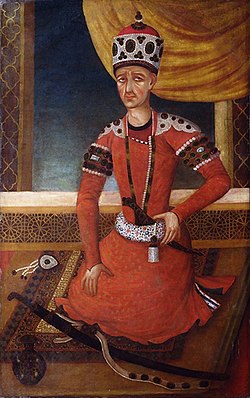Aga Muhammed Khan
| Den här artikeln har källhänvisningar, men eftersom det saknas fotnoter är det svårt att avgöra vilken uppgift som är hämtad var. (2021-04) Hjälp gärna till med att redigera artikeln, eller diskutera saken på diskussionssidan. |
| Aga Muhammed Shah | |
|---|---|
| Šāhanšāh-e Irān | |
 | |
| Porträtt från cirka 1820 | |
| Regeringstid | 1789 – 17 juni 1797 |
| Kröning | mars 1796 |
| Företrädare | Lotf Ali Khan |
| Efterträdare | Fath-Ali Qajar |
| Gemål | Maryam Khanom |
| Personnamn | Aga Muhammed Khan Qajar |
| Ätt | Qajar |
| Far | Muhammed Qajar |
| Mor | Jeeran Khanum |
| Född | 14 mars 1742 Astarabad, Iran |
| Religion | Tolv-shiitisk islam |
| Död | 17 juni 1797 (55 år) Sjusja, Iran |
| Begravd | Alis moské, Najaf, Irak |
 | |
| Khans tugra användes som monogram | |
 | |
| Vapnet på Khans flagga under Qajar | |
Aga Muhammed Khan Qajar (persiska: آغا محمد خان قاجار; även känd under regentnamnet Muhammed Khan Shah), född 14 mars 1742 i Astarabad, död 17 juni 1797 i Sjusja, var en persisk kung av Qajardynastin.
Biografi
Efter en svår ungdom, då Khan upprepade gånger tillfångatogs och även kastrerades, ledde han den turkmenska Qajarstammen till seger över Zanddynastin. Med skicklighet och hänsynslöshet utmanövrerade Aga Muhammed på 1780-talet de sinsemellan stridande Zandprinsarna och etablerade sin dynasti på Persiens tron. År 1785 gjorde han för första gången Teheran till landets huvudstad. Efter ett framgångsrikt krigståg till Georgien år 1795–1796 lät Aga Muhammed Khan slutligen kröna sig till shah men mördades redan året därpå och efterträddes av sin brorson Fath-Ali Shah.
Referenser
- Nationalencyklopedin, multimedia plus. 2000.
Externa länkar
 Wikimedia Commons har media som rör Aga Muhammed Khan.
Wikimedia Commons har media som rör Aga Muhammed Khan.
|
Media som används på denna webbplats
افوض امری الی الله عبده محمد
Författare/Upphovsman: Mysid, Licens: CC0
Coat of Flag of Iran during the Qajar dynasty, i.e. the flag of Agha Mohammad Khan.
Artwork of Mohammad Khan Qajar, the founder of the Qajar dynasty of Iran (1785–1925).
Christies description:
FULL LENGTH PORTRAIT OF AGA MUHAMMAD KHAN QAJAR QAJAR IRAN, CIRCA 1820 Oil on canvas, Aga Muhammad Khan kneels on a rug, hand on hip, wearing a red embroidered robe with jewelled sleeves, tall pearl and emerald embellished hat, floral sash with dangling pearl tassle and dagger tucked in, with studded belt and sword of state in front of him and draped curtain behind, a few areas where the paint has chipped, areas of repainting, unframed.
There existed, in the early Qajar period, a tradition of 'historical' portraiture, important as dynastic legitimacy continued to be an issue of consequence. The numerous depictions of the Qajar royal family were perhaps intended to reinforce the length of the pedigree and the importance of the dynasty. Charles Texier counted some 60 in different palaces (Vol. II, 1853, pp.128-9, referenced in Julian Raby, Qajar Portrai ts, London, 1999, p.49). The tradition was well established by the time Fath 'Ali Shah acceded to the throne, and it must certainly have played a role in the projection of his monarchical pretensions (Raby, op. cit., p.49). Aga Muhammad Khan (1742-97), as the man credited with the establishment of the Qajar dynasty, is unusual as subject matter but logical when considered within this framework of portraiture as a mechanism for portraying political legitimacy.
The facial style of Aga Muhammad Khan in this work is interesting. There seemed to be a tendency towards depicting faces either with a distinct youthful innocence or old and wizened. In two of a series of historical portraits by Mehr 'Ali published in Raby's Qajar Portraits (Nos. 115-6, pp.50-1), the features of Afrasiyab, the King of Turan and Chingiz Khan are painted in the latter style, riddled with wrinkles and with soft features and downcast expression, reminiscent of the present example.A text document icon with a red question mark overlaid. This icon is intended to be used in e.g. "unverified content" templates on Wikipedia.




